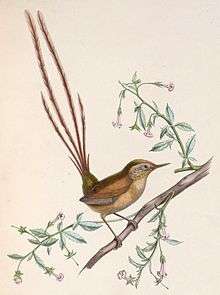Des Murs's wiretail
Des Murs's wiretail (Sylviorthorhynchus desmursii) is a small passerine bird of southern South America which belongs to the ovenbird family Furnariidae. It is the only member of the genus Sylviorthorhynchus. Molecular phylogenetics places it within the Synallaxinae and indicates that the genus diverged from the Leptasthenura about 14-15 million years ago.[2]
| Des Murs's wiretail | |
|---|---|
 | |
| Scientific classification | |
| Kingdom: | Animalia |
| Phylum: | Chordata |
| Class: | Aves |
| Order: | Passeriformes |
| Family: | Furnariidae |
| Genus: | Sylviorthorhynchus |
| Species: | S. desmursii |
| Binomial name | |
| Sylviorthorhynchus desmursii Gay, 1845 | |
Description
It is 24 centimetres (9.4 in) long, with the very long tail accounting for about two-thirds of this, but weighs as little as 10 grams (0.35 oz).[3] The tail consists of just six feathers which are very narrow and filament-like: so few rectrices are elsewhere seen only in the emu-wrens of Australia.[4] The two central feathers are greatly elongated while the two outer feathers are very short. The plain plumage is reddish-brown above, paler on the underparts. There is a pale stripe above the eye. The bird is small and rounded with a very fine bill. The song is fast and high-pitched.
Distribution and habitat
It is found in western Argentina from Santa Cruz Province north to San Juan and in southern and central Chile from northern Magallanes to Valparaíso Region. It inhabits dense thickets of Chusquea bamboo within cool temperate rainforests, occurring from sea-level up to 1,200 metres, but also can occur in early-successional shrublands of highly shade-tolerant Myrtaceae species, chiefly Amomyrtus.[5] Des Murs's wiretail is also known to occur in dense weedy thickets of plants like gorse over the northern extremity of its range.[5] Even in undisturbed rainforests, however, wiretails use only the low-level shrub and bamboo layer for foraging, never flying higher than 3 metres (10 ft) above the ground.
Behaviour and ecology
It is very shy and difficult to see, being completely unable to enter areas without dense vegetative overstoreys,[6] and cannot typically use corridors smaller than 25 metres (80 ft) or fly further than 50 metres (160 ft) between patches of suitable habitat.[7]
When encountered Des Murs's wiretail can easily be mistaken for a mouse. It has the unique ability among birds to curl up its long tail into a ball when alarmed.[3]
The ball-shaped nest is made of plant fibres and built amongst vegetation close to the ground. Both partners are highly territorial with a territory size of around 1 hectare (2.5 acres) per pair; however, pairs in territories smaller than 20 hectares (49 acres) are seldom successful at nesting.[5] This territory and the nest site are defended vigorously against conspecifics with a distinctive territorial song,[7] and it is possible that the long tail is used by both sexes as an means of choosing a mate,[8] though no actual tests have been used to determine how wiretails find a mate.
As is typical for south temperate insectivorous birds, during the breeding season of October to February Des Murs's wiretail lays a clutch of two to four eggs,[7] but for the bird's mass these are about the largest eggs of any passerine bird. At 20.5 millimetres (0.807 in) long and 15.8 millimetres (0.622 in) wide,[3] they weigh twice as much as expected for a 10 gram passerine[9] and a clutch of four weighs more than the adult female - a feat equalled only by much more fecund kinglets. Little is known about incubation, fledging periods, or postfledging parental care due to the very secretive nature of the species.
References
- BirdLife International (2012). "Sylviorthorhynchus desmursii". IUCN Red List of Threatened Species. 2012. Retrieved 26 November 2013.CS1 maint: ref=harv (link)
- Gonzalez, J. & M. Wink (2008) Phylogenetic position of the monotypic Des Murs’ Wiretail (Sylviorthorhynchus desmursii, Aves: Furnariidae) based on mitochondrial and nuclear DNA. Journal of Ornithology 149(3):393-398 doi 10.1007/s10336-007-0251-0
- Johnson, Alfredo William (author) and Goodall, J.D. (illustrator); The birds of Chile and adjacent regions of Argentina, Bolivia, and Peru, Volume II; pp. 171-173.
- Sibley, Charles Gald and Alquist, John E.; Phylogeny and Classification of the Birds: A Study in Molecular Evolution; p. 576. ISBN 0300040857
- Diáz, Iván A., Armesto, Juan J. and Willson, Mary F.,“Mating success of the endemic Des Murs’ Wiretail (Sylviorthorhynchus desmursii, Furnariidae) in fragmented Chilean rainforests”
- Sieving, Katharyn E, Willson, Mary F. and de Santo, Toni L.; “Defining Corridor Functions for Endemic Birds in Fragmented South-Temperate Rainforest”
- Diáz, Iván A., Willson, Mary F., Gehee, Steven M.C. & Armesto, Juan J.; “Observaciones Sobre La Biologia y Conservación del Colilarga (Sylviorthorhynchus desmursii, Furnariidae) en la Isla de Chiloé, Chile”
- See Moreno, Juan, Merino, Santiago, Lobato, Elisa, Rodríguez-Gironés, Miguel A. and Vásquez Rodrigo A.; “Sexual dimorphism and parental roles in the thorn-tailed rayadito (Furnariidae)” in The Condor 109(2):312-320 (2007)
- Based on the formula of egg mass = 0.258m0.73, where m is body mass. From Rahn, H., Sotherland, P. and Paganelli, C. V., 1985. “Interrelationships between egg mass and adult body mass and metabolism among passerine birds” in Journal für Ornithologie 126:263-271.
- Jaramillo, Alvaro; Burke, Peter & Beadle, David (2003) Field Guide to the Birds of Chile. Christopher Helm, London.
